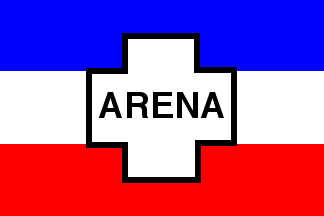
image by Ivan Sache, 16 March 2003

Last modified: 2014-10-04 by zoltán horváth
Keywords: el salvador |
Links: FOTW homepage |
search |
disclaimer and copyright |
write us |
mirrors
See also:
There are elections in El Salvador this sunday, and on <upd.tse.gob.sv>
you can see all the flags of the 11 political parties that are
participating.
Fred Drews, 14 March 2003
There are presidential elections in El Salvador this month on
the 21st and there are only 6 parties participating of which only
one is a new party. The parties are:
- PCN - Partido de Conciliacion Nacional
- PDC - Partido Democrata Cristiano
- FMLN - Frente Farabundo Martí para la
Liberación Nacional
- ARENA - Partido Alianza Republicana
Nacionalicta
- PNL - Partido Nacional Liberal (new!)
- CDU - Centro Democratico Unido
Fred Drews, 3 March 2004
Today there are elections in El Salvador for mayors and
legislators. 6 parties are participating:
- ARENA
- CD
- FMLN
- PCN
- PDC
- PNL
Fred Drews, 12 March 2006

image by Ivan Sache, 16 March 2003
Based on image from <upd.tse.gob.sv>.
This party took part in 2003 elections.
Fred Drews, 14 March 2003
![[El Salvador - Bloque Popular Revolucionario]](../images/s/sv}bpr.gif)
image by Randy Young, 21 January 1999
On a red field, a red star centered within a white triangle
that's based on the hoist. I'm assuming from the name of the
party and the red star that they have some socialist or communist
connection.
Source: William Crampton, "The Complete Guide to
Flags," printed in 1989.
Randy Young, 21 January 1999
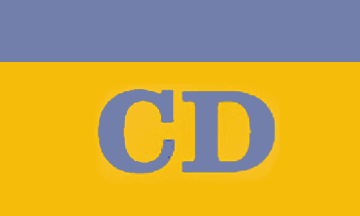
image by Fred Drews, 12 March 2006
This party took part in 2006 elections.
Fred Drews, 12 March 2006

image by Ivan Sache, 16 March 2003
Based on image from <upd.tse.gob.sv>.
This party took part in 2003 elections.
Fred Drews, 14 March 2003
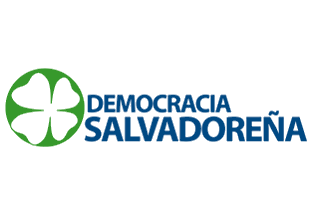
image by Fred Drews, 14 August 2014
Democracia Salvadoreña (DS) was established in 2013 by Adolfo Salume
Artiñano. The party was officially registered on 13 September 2013 by the
Electoral Supreme Court, as "Partido Democracia Salvadoreña" (PDS). The party
was joined on 24 July 2014 by the three Representatives Wilfredo Iraheta
Sanabria, Claudia Ramírez, and Sigfrido Ochoa Pérez. DS expects to compete in
the 2015 general elections.
The party's colours and emblem are described in Article of the party's Statutes:
Democracia Salvadoreña has for distinctive colours blue, green, and white. Blue
is used in the writing "DEMOCRACIA SALVADOREÑA" , while green and white are used
in the emblem. The emblem is made of an logotype inscribed in a disc, whose
shape suggests a clover with four irregular leaves, visually from right to left
starting at the bottom of the disc. At the right side of the circle is the
writing "Democracia Salvadoreña", in capital letters of the font Myriad Pro
bold. The text is written on two lines; the first line, representing 75% of the
whole text's width, reads 'DEMOCRACIA', proportionally fitted to the first eight
letters of "SALVADOREÑA", which is written on the second line, representing 100%
of the text's width. The colour of the letters is blue Pantone 2945c.
The initial of each word (DS) may be used for a concise reading of the party's
emblem. THe colour of the disc is green Pantone 361 c.
Source:
http://www.ds.com.sv/2_0/estatutos/ESTATUTOS%20DS-TSE.pdf - DS Statutes
Ivan Sache, 14 August 2014

image by Ivan Sache, 17 June 2005
The political party "Frente Democrático
Revolutionario" (FDR) has been formed by 117 dissidents from
"Frente Farabundo Martí para la Liberación Nacional"
(FMLN), including four MPs and their
deputies. On 15 June 2005, the leaders of the new party have
registered their statutes with the Election Supreme Court
("Tribunal Supremo Electoral"). The provisory general
coordinator of FDR is Julio Hernández. The deputy coordinator is
Francisco Jovel, member of the general command of FMLN during the
civil war. The new party has decided not to participate to the
next general and municipal elections (2006), but will have a
candidate for the next presidential election (2009). The flag of
FDR is red with the acronym of the party in yellow letters.
Sources: Diario
El Mundo - 15 June 2005, La Prensa
Gráfica - 16 June 2005.
Reconstituted image (no image of the real flag seen yet).
Ivan Sache, 17 June 2005
Salvadorian newspapers report that the political party Frente
Democrático Revolucionario (FDR) has started the process of
changing its flag, logotype and motto. The proposals shall follow
the Electoral Code, which prohibits the use by political parties
of the name or acronym of state institutions as well as the use
of the flag or arms of other countries. All citizens of Salvador
can propose symbols for the party. The first prize will be a
computer, the second and the third prize will be a digital
camera. The deadline is 26 June 2006. The new flag is expected to
be unveiled during the General Assembly of FDR scheduled on 23
July 2006.
The current flag of FDR, which was founded in June 2005, was
reported to be red with the party acronym in yellow letters.
Sources: Diario
Colatino - 6 June 2006, La Prensa
Gráfica - 7 June 2006.
Ivan Sache, 8 June 2006
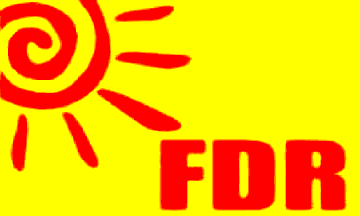
image by António Martins-Tuválkin, 22 May 2010
The political Party FDR have a new flag design.
Fred Drews, 12 August 2009
At
http://es.wikipedia.org/wiki/Frente_Democr%C3%A1tico_Revolucionario it is
said that this 1980-1988 Salvadorean political party coalition, merged in 1988
to became Convergencia Democrática, was in 2006 the inspiration
for a breakaway ex-F.M.L.N.-ers for their new party, which «took the name and flag of the historical F.D.R.».
In the Spanish Wikipedia article the date 2006 is incorrect, comparing with
Ivan’s sources, stating foundation in June 2005 and a contest
for a new party flag in July 2006.
I think that the red flag with yellow letters is the flag of the
1980-1988 party, and of the 1st year (2005-2006) of the later party with the
same name; the yellow flag with sun and red letters is probably the flag of the
later party adopted in July 2006.
António Martins-Tuválkin, 22 May 2010
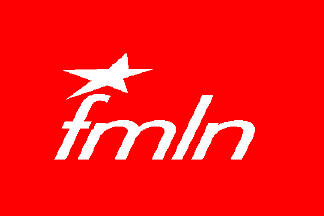
image by Ivan Sache, 16 March 2003
Image of the flag at <www.netcomsa.com/fmln>.
Dov Gutterman, 10 March 1999
Based on image from <upd.tse.gob.sv>.
This party took part in 2003 elections.
Fred Drews, 14 March 2003
Brief description: Farabundo Marti National Liberation Front.
Mothertongue Name: Frente Farabundo Martí para la Liberación
Nacional (FMLN).
Base of Operation: El Salvador.
Founding Philosophy: Nicaragua was plagued by several terrorist
organizations in the 1970s and 1980s. Terrorists fought for both
rightist and leftist ideologies. In the late 1970s, Cuba's Fidel
Castro offered financial aid to a number of Communist and leftist
insurgent groups in El Salvador. As a precondition to receiving
Cuban aid, the leftist groups would first have to centralize
their military command. On the 17th of December 1979, in period
of national crisis, the three dominant Marxist organizations
(FPL, RN and PCS) in El Salvador formed the Coordinadora
Político-Militar (in order to fulfill Castro's requirement). The
CPM's first manifesto was released on 10th of January 1980, and
the day afterwards the Coordinadora Revolucionaria de Masas was
formed as a union of revolutionary mass organizations. CRM later
merged with the Frente Democrático Salvadoreño to form the
Frente Democrático Revolucionario.
On May 22nd, 1980, the Dirección Revolucionaria Unificada was
created by the FPL, RN, EPL and PCS. DRU consisted of three
Political Commission members from each of these four
organizations. The DRU manifesto declared, "There will be
only one leadership, only one military plan and only one command,
only one political line."
On the 10th of October 1980 the four organizations formed the
Frente Farabundo Martí de Liberación Nacional (FMLN). In
December of the same year, the Salvadoran branch of the Partido
Revolucionario de los Trabajadores Centroamericanos broke away
from its central organization and affiliated itself to FMLN. Thus
the following organizations composed FMLN (listed in the order of
size at the time of the peace accords in 1992):
- Fuerzas Popular de Liberación "Farabundo Martí"
(FPL)
- Partido Comunista de El Salvador, armed wing Fuerzas Armadas de
Liberación (PCS)
- Partido de la Revolución Salvadoreña, armed wing Ejército
Revolucionario del Pueblo (ERP)
- Fuerzas Armadas de la Resistencia Nacional (RN)
- Partido Revolucionario de los Trabajadores Centroamericanos,
armed wing Ejército Revolucionario de los Trabajadores
Centroamericanos (PRTC).
For the next decade, FMLN would engage in a terrorist insurgency
within El Salvador. FMLN's goal was to recreate El Salvador as a
Communist state. The group took its inspiration from its two
financial sponsors, Cuba and the Sandinistas of Nicaragua. In
fact, the ability of both Castro's government and the Sandinistas
to successfully perpetuate and win a Communist revolution was
proof to FMLN that their objective was not impossible.
After the formation of the front, FMLN launched a major military
offensive on the 10th of January 1981.
The organization was named for the rebel leader Farabundo Martí,
who led workers and peasants in an uprising to transform
Salvadoran society after the devastation caused by the eruption
of the volcano Izalco in 1932. In response, the military regime
led by General Maximiliano Hernández Martínez, who had seized
power in a 1931 coup, launched an effective but brutal
counterinsurgency campaign that saw 30,000 suspected guerrillas
and Martí supporters killed.
In the end, FMLN did not overthrow the Salvadoran government and
El Salvador did not morph into a Communist state. However, it
took a decade of bloodshed and destruction before FMLN finally
accepted its inability to affect significant change.
After the ceasefire established by the 1992 Chapultepec Peace
Accords, the FMLN became a legitimate political party. Its
candidate for the 2004 presidential election was Schafik Handal.
Today there are two main tendencies within the party, the
"ortodoxos" (mainly former Partido Comunista militants)
and "renovadores" (mainly former FPL militants).
Current Goals: FMLN initiated its first major offensive against
El Salvador' military in January 1981. It failed. The
organization retreated to the countryside and concentrated on
increasing membership. During this time, group membership reached
over 10, 000 active members. In this period, FMLN would directly
engage in force the military forces of El Salvador. By the late
1980s, FMLN's insurgency was still unsuccessful and was
faltering. After 1988, the group expanded its terrorist tactics
to include attacks within urban areas. Still, the conflict
dragged on and a Communist state did not seem probable, though
persisting terrorist attacks, fatalities, and injuries
predictably continued. In late 1989, FMLN commenced another major
offensive. Again, it failed. Following a decade of failed
insurgency, FMLN finally reached a peace settlement with the
Salvadoran government on December 31, 1991. The Marti National
Liberation Front (FMLN) is no longer an active terrorist
organization. Today, FMLN is a legal political party in El
Salvador.
Sources: <www.tkb.org>,
<en.wikipedia.org>.
E. R., 27 June 2005
Variant

image from WikiPedia
The variant is located in WikiPedia.
The author of this entry states the following: "Banner used
until 1992. Clarification: the official FMLN banner was red and
white; the red and yellow version shown above was used by the
FPL. Photos of the celebration of the peace accords on January
16,1992 by the whole FMLN show the red and white flag, which,
slightly adapted, became the banner of the legal political
party."
E. R., 31 December 2007
FPL (Fuerzas Popular de Liberación "Farabundo Martí")
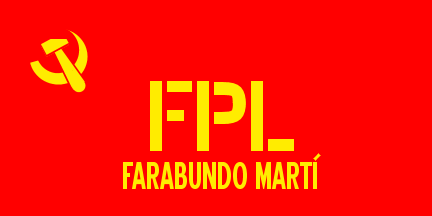
first version
image by Eugene Ipavec, 31 December 2007
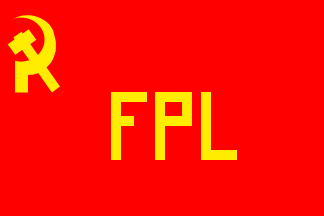
second version
image by Eugene Ipavec, 31 December 2007
.gif)
logo
image from <www.cedema.org>
The FMLN was an amalgamation of several factions. One of these
factions was the FPL (Fuerzas Popular de Liberación
"Farabundo Martí" - "Farabundo Marti"
Popular Liberation Forces). The FPL was founded on April 1, 1970
as a dissident group of the PCS (Partido Comunista
Salvadoreño - Salvadorean Communist Party). This was the
biggest leftist guerrilla group in the 1970's until they merged
with other groups into the FMLN. In 1975 the BPR
(Bloque Popular Revolucionario - Revolutionary Popular
Bloc) was established to organize popular support, mainly
peasants and unions that agreed with the movement. On January 16,
1992 the Acuerdos de Paz de Chapultepec (Chapultepec
Peace Agreements) were signed and later on the FPL laid down its
weapons, and in 1995 they fully demobilized themselves and became
a political party inside the FMLN.
E. R., 31 December 2007
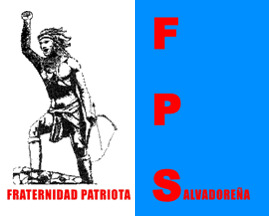
image by Fred Drews, 15 August 2014
In "Diario El Mundo" (1), 9 May 2006, Edgardo Rivera
reports that Fraternidad Patriota Salvadoreña (FPS) is about to
become the sixth political party registered with the Electoral
Supreme Court for the general elections of 2009.
The FPS is mostly composed of former soldiers and members of the
former National Police, but includes also lawyers, businessmen
and students. Oscar Lemus, President of the FPS, says that the
party belongs to the humanist and progressist right. The party
has its seat in Santa Tecla.
Anyway, the FPS has already a flag, vertically divided
white-blue. The white half is charged with a person raisong the
right arm, surmonting the writing FRATERNIDAD PATRIOTA in red,
whereas the blue half is charged with the red letters FPS placed
vertically and the writing SALVADOR (or SALVADORENA?)
horizontally, sharing the S of FPS, so that the full name of the
party can be read horizontally on the bottom of the flag.
A photography by Franklin
Zelaya in "Diario El Mundo" shows Oscar Lemus
presenting a plate showing the party flag, whereas a real party
flag is hanging on the wall behind him.
Source: <www.elmundo.com.sv>.
Ivan Sache, 11 May 2006
Diario El Mundo, 11 May 2006, has an article dedicated to the
new political party FPS, giving an explicit description of the
party symbols as: "As a symbol the party uses an Indian, who
represents the native peoples, and the party flag is vertically
divided blue and white.". The picture of the flag showed the
Indian and the party name in red, and was divided white and blue,
therefore we should better wait for more images of the flag
before deciding how it is really.
Source: <www.elmundo.com.sv>.
Ivan Sache, 13 May 2006
The FPS, re-established on 17 June 2011, was officially registered for the
2014 presidential elections on 22 October 2013 by the Electoral Supreme Court.
The ticket for the election is composed of Óscar Lemus and of Rafael Menjívar.
Source:
http://noticias.lainformacion.com/politica/candidatos-politicos/fraternidad-patriota-salvadorena-inscribe-su-formula-presidencial-para-2014_dkPjPGxtIveEw4ex7x9fx7/
The FPS ticket gained 6,659 votes (0.25%) at the first round of the presidential
election of 2 February 2014, and could not qualify for the second round.
The flag in actual use has the right stripe in a much darker shade of blue than
on the party's logo.
Photos:
http://www.newsmillenium.com/2013/07/02/fps-se-pronuncia-ante-diversos-temas/
http://www.newsmillenium.com/2011/06/21/fps-estructurado-con-capital-de-sus-miembros/
http://www.laprensagrafica.com/presidencia-de-el-salvador-sera-disputada-por-cinco-candidatos
>
Ivan Sache, 15 August 2014
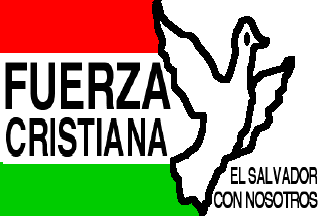
image by Ivan Sache, 16 March 2003
Based on image from <upd.tse.gob.sv>.
This party took part in 2003 elections.
Fred Drews, 14 March 2003

image by Zoltan Horvath, 11 March 2014
"Grand Alliance for National Unity (Spanish: Gran Alianza por la Unidad
Nacional or GANA) is a political party in El Salvador. The party established
itself on 16 January 2010. The majority of party members came from the
ARENA. GANA is a conservative and right-wing party.
Nevertheless, it forms a parliamentary coalition with the ruling leftist
FMLN. GANA ranks third in seats in the Asamblea Legislativa
(Legislative Assmebly) after FMLN and ARENA, first and second, respectively.
GANA is an acronym which means win in Spanish."
Source:
http://en.wikipedia.org/wiki/Grand_Alliance_for_National_Unity
The flag is a horizontal
orange flag
with the party's name in the middle in blue (the initials) and in white (party's
full name) as seen
here and
here.
Sources:
http://www.elsalvadornoticias.net/2010/04/17/gana-presenta-70-mil-firmas-al-tse-para-su-inscripcion/
http://www.gana.org.sv/2011/07/alfredito-lemus-tiene-listo-su-%E2%80%9Cconcejo%E2%80%9D-para-ganar-comuna-de-santa-ana/#
)
For additional information go to GANA
(official website)
Esteban Rivera, 09 March 2014
Previous version:
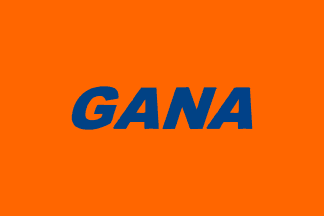
image by Zoltan Horvath, 11 March 2014
I found another variant or previous variant of this party flag, It has only
blue abbreviation on orange field. Pictures below were taken in 2011.
http://www.newsmillenium.com/wp-content/uploads/2011/02/GANA.jpg
http://www.newsmillenium.com/wp-content/uploads/2011/10/Heber-Flores-300x225.jpg
Zoltan Horvath, 11 March 2014
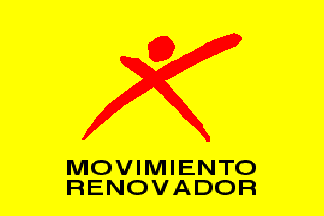
image by Ivan Sache, 16 March 2003
Based on image from <upd.tse.gob.sv>.
This party took part in 2003 elections.
Fred Drews, 14 March 2003

image by Ivan Sache, 16 March 2003
Based on image from <upd.tse.gob.sv>.
This party took part in 2003 elections.
Fred Drews, 14 March 2003

image by Ivan Sache, 16 March 2003
Based on image from <upd.tse.gob.sv>.
This party took part in 2003 elections.
Fred Drews, 14 March 2003

image by Fred Drews, 17 October 2001
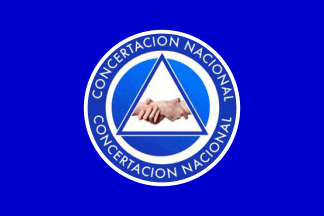
image by Zoltan Horvath, 11 March 2014
"The Partido de Concertación Nacional (National Coalition Party) is a
conservative party established on September 30, 1961 and until 2011 it
was known as the Partido de Conciliación Nacional, PCN). It was the most powerful
political party in the country during the 1960s and 1970s, and was
closely associated with the Salvadorean military. All the Presidents
from 1962 onwards, until the 1979 coup d'etat were from this political
party. After the 1979 revolution the party declined in influence but
continued to exist. Today, it is considered relatively minor as
compared with the two major organizations,ARENA and the FMLN. With
none of these two parties holding a majority, PCN can be seen as
holding the balance of power. However, it usually sides with the
conservative ARENA party.
While the party was technically to be disbanded after the 2004
election, in which its candidate did not gather the necessary 3% of
the vote, it was allowed to hold onto its registration by Decree; this
Decree was declared unconstitutional on 30 April 2011, and the party
was thus disbanded. The party was de facto re-established, registering
with the Supreme Electoral Tribunal as the National Coalition
('Concertación Nacional', CN) in September 20, 2011 (after two rulings
from the Tribunal Superior de Justicia and one by the Tribunal Supremo
Electoral ratifying th existence of the party. After one year, it
added the word 'Partido' ("party") to its full name, which allowed it
to again use the traditional acronym PCN".
Sources:
http://www.partidoconcertacionnacional.org.sv/concertacion-nacional/origenes/partido-de-conciliacion-nacional.html ,
http://www.partidoconcertacionnacional.org.sv/concertacion-nacional/historia-moderna.html ,
http://en.wikipedia.org/wiki/National_Coalition_(El_Salvador) and
http://es.wikipedia.org/wiki/Partido_de_Conciliaci%C3%B3n_Nacional
The party's flag (post 2011 refoundation) is currently a blue
horizontal flag with the
logo in the middle as seen
here.
Source:
http://especiales.laprensagrafica.com/2012/elecciones/03/02/cn-a-primera-prueba-de-fuego/
For additional information go to
PCN (official website)
Esteban Rivera, 09 March 2014
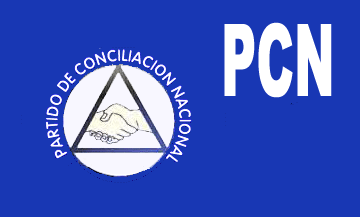
image by Fred Drews, 12 March 2006
See also another (and a bit different) image from <upd.tse.gob.sv>.
This party took part in 2003 elections.
Fred Drews, 14 March 2003
See also desk flag and logo at <snluislaherra.isdem.gob.sv>.
Dov Gutterman, 7 November 2004

image by Fred Drews, 17 October 2001

image by Fred Drews, 12 March 2006
Based on image from <upd.tse.gob.sv>.
This party took part in 2003 elections.
Fred Drews, 14 March 2003

image by Fred Drews, 17 October 2001
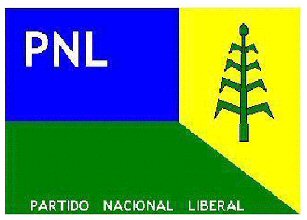
image from <www.elecciones2004.com.sv>
There are presidential elections in El Salvador this month on
the 21st, and there are only 6 parties participating of which
only one is a new party.
Fred Drews, 3 March 2004
"El Diario de Hoy", 7 October 2007, has an article
on the next elections (2009); on the electronic edition, there is
a small, clickable photography, on which the flag of the PLN can
be seen on a wall. The flag shown there is fairly similar to the
one above, but the name of the party, written on the bottom of
the flag, and its acronym, written in upper hoist, are yellow
instead of white. The plant shown in the yellow field of the
flag, probably maize, seems to be less stylized on the real flag
than on the graphic shown above.
Source: <www.elsalvador.com>.
Ivan Sache, 8 October 2007
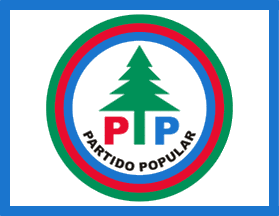
image by Fred Drews, 15 August 2014
image from <upd.tse.gob.sv>.
This party took part in 2003 elections.
Fred Drews, 14 March 2003

image by Fred Drews, 17 October 2001
image from <upd.tse.gob.sv>.
This party took part in 2003 elections.
Fred Drews, 14 March 2003
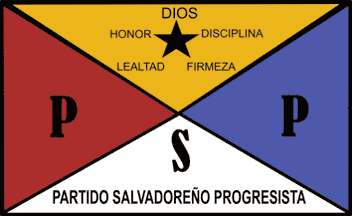
image by Fred Drews, 15 August 2014
The PSP, established in 2011, was officially registered for the 2014
presidential elections on 18 October 2013 by the Electoral Supreme Court. The
ticket for the election is composed of the retired Lieutenant Colonel René
Rodríguez Hurtado (b. 1952) and of Adriana Bonilla.
Source:
http://www.elsalvadornoticias.net/2013/10/20/partido-salvadoreno-progresista-inscribe-formula-presidencial-para-elecciones-2014/
The PSP ticket gained 11,314 votes (0.42%) at the first round of the
presidential election of 2 February 2014, and could not qualify for the second
round.
The flag actually used by the party is made of the rectangular party's emblem
framed by a black line and surrounded by a white border.
Photos:
http://www.elsalvadornoticias.net/wp-content/uploads/2013/10/PSP-2.jpg
http://www.laprensagrafica.com/el-salvador/social/262119-tribunal-verifica-firmas-para-avalar-inscripcion-de-partido-de-exmilitares.html
Video:
https://www.youtube.com/watch?v=5nvNJY6i0Vo
Ivan Sache, 15 August 2014

image by Fred Drews, 17 October 2001
Previous flag of Partido Renovacio'n Social Cristiano
image from <www2.insatelsa.com>, located by Dov Gutterman, 10 March 1999
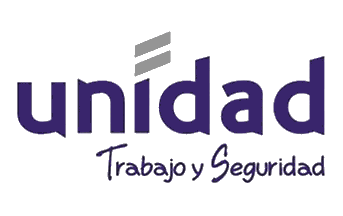
image by Fred Drews, 14 August 2014
Unidad (Unity) was a coalition of three centrist parties, GANA (Gran Alianza
por la Unidad Nacional), PCN (Partido de Concertación Nacional), and PDC
(Partido Demócrata Cristiano), established on 5 May 2013 by Elías Antonio Saca
(b. 1965; President of the Republic from 2004 to 2009) to support his candidacy
at the 2014 presidential election. Saca presented the coalition as an
alternative to the two traditional parties, ARENA and FMLN.
The original flag of Unidad featured a portrait of Antonio Saca, three
horizontal stripes with the national colours,and the coalition's name. Following
a complaint by ARENA and FMLN, the Supreme Court of Justice declared the flag
not compliant with the Constitution, because of Saca's portrait. Unidad claimed
that the portrait had a generic value and "that it could not be proved with
certainty that the portrait was the photo of a specific person". The Electoral
Supreme Court subsequently ordered the party "to correct its plans" within 72
hours, without explicitly saying what should be corrected. Antonio Saca promised
he would not change the flag, but the portrait was soon removed from the flag.
On 2 February 2014, Saca came third, with 11.4% of the votes, at the first round
of the election, and could not qualify for the second round. On 27 June 2014,
the Supreme Court of Justice declared Saca's candidacy's not compliant with the
Constitution, since he should have respected a delay of 10 years since his first
tenure.
Sources:
http://www.lapagina.com.sv/nacionales/87023/2013/09/17/Imagen-de-Tony-Saca-en-bandera-de-UNIDAD-genera-molestia-en-resto-de-partidos-
- La Página, 19 September 2013
http://eltiempolatino.com/news/2014/jun/27/el-salvador-candidatura-de-antonio-saca-fue-ilegal/
- El Tiempo Latino, 27 June 2014
The party flags officially recognized by the Electoral Supreme Court are shown
on the Court's website. THe issue is of significance since the flags are printed
on the ballot papers.
Source:
http://tsesv.blogspot.fr/2013_11_01_archive.html
Ivan Sache, 14 August 2014